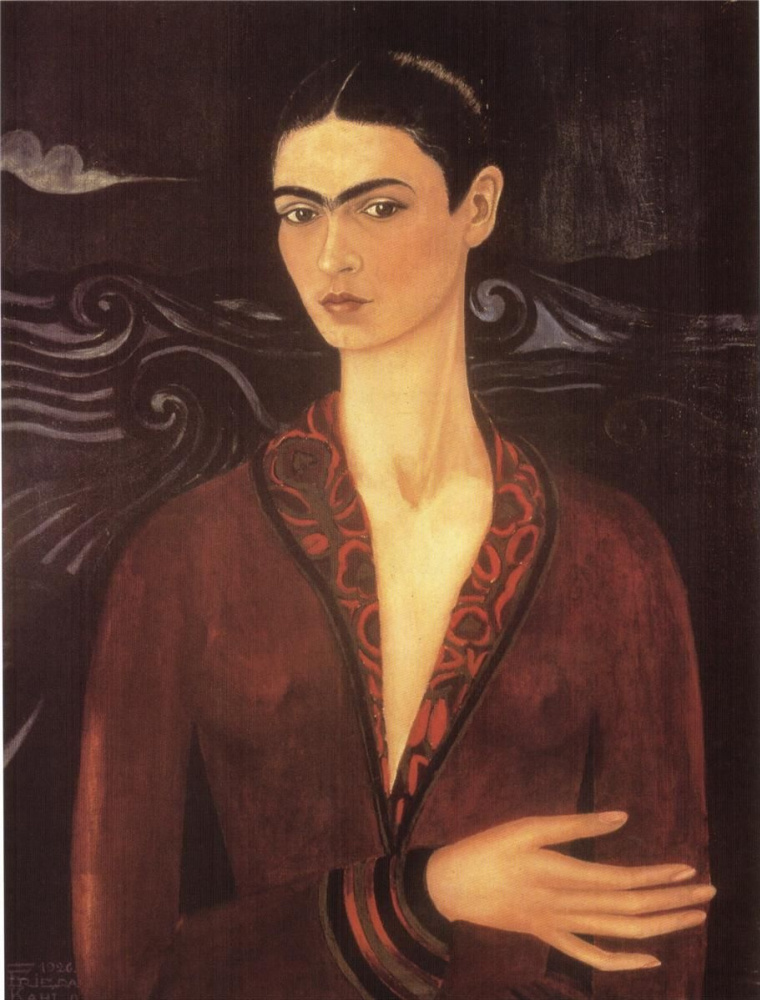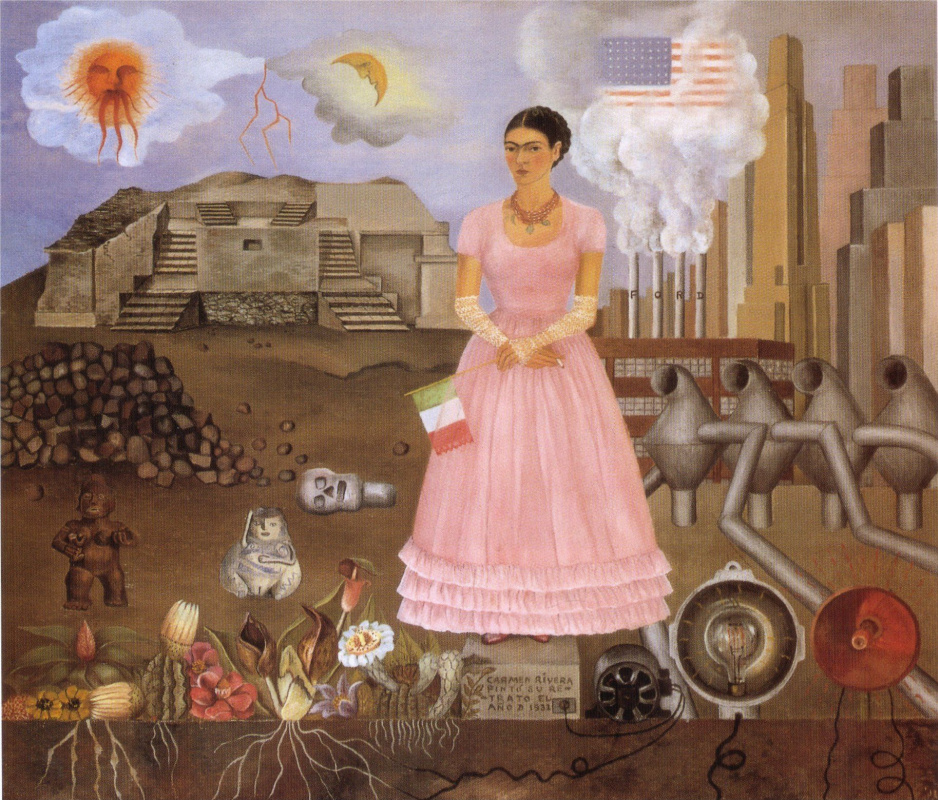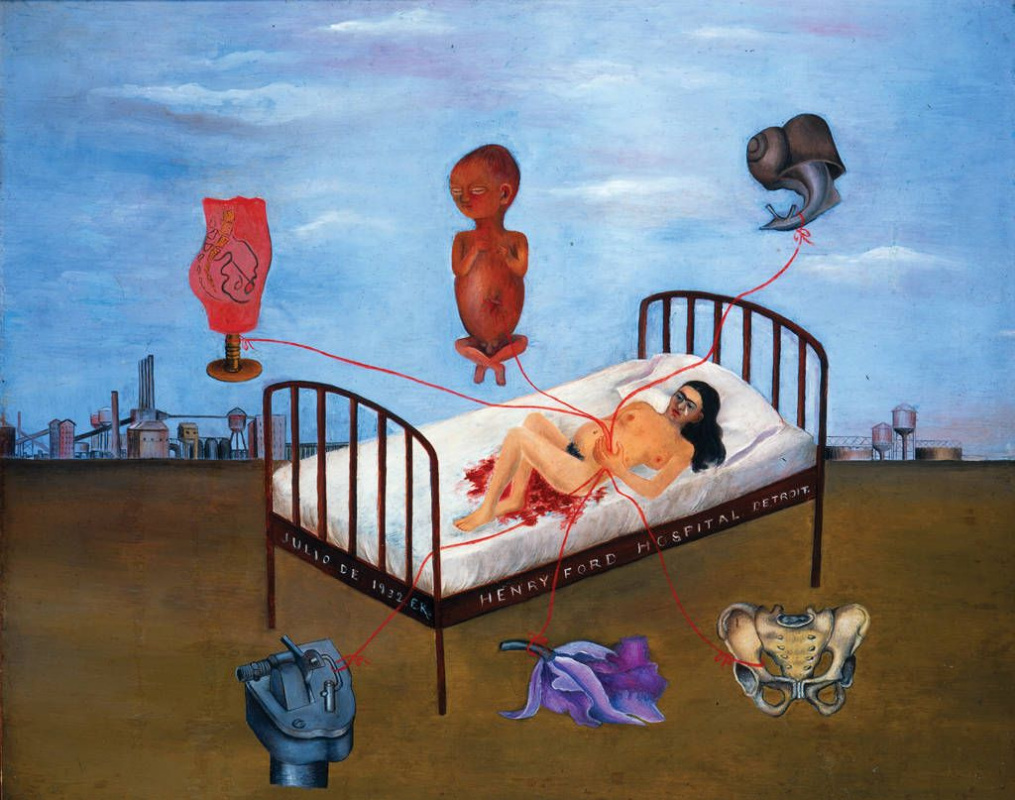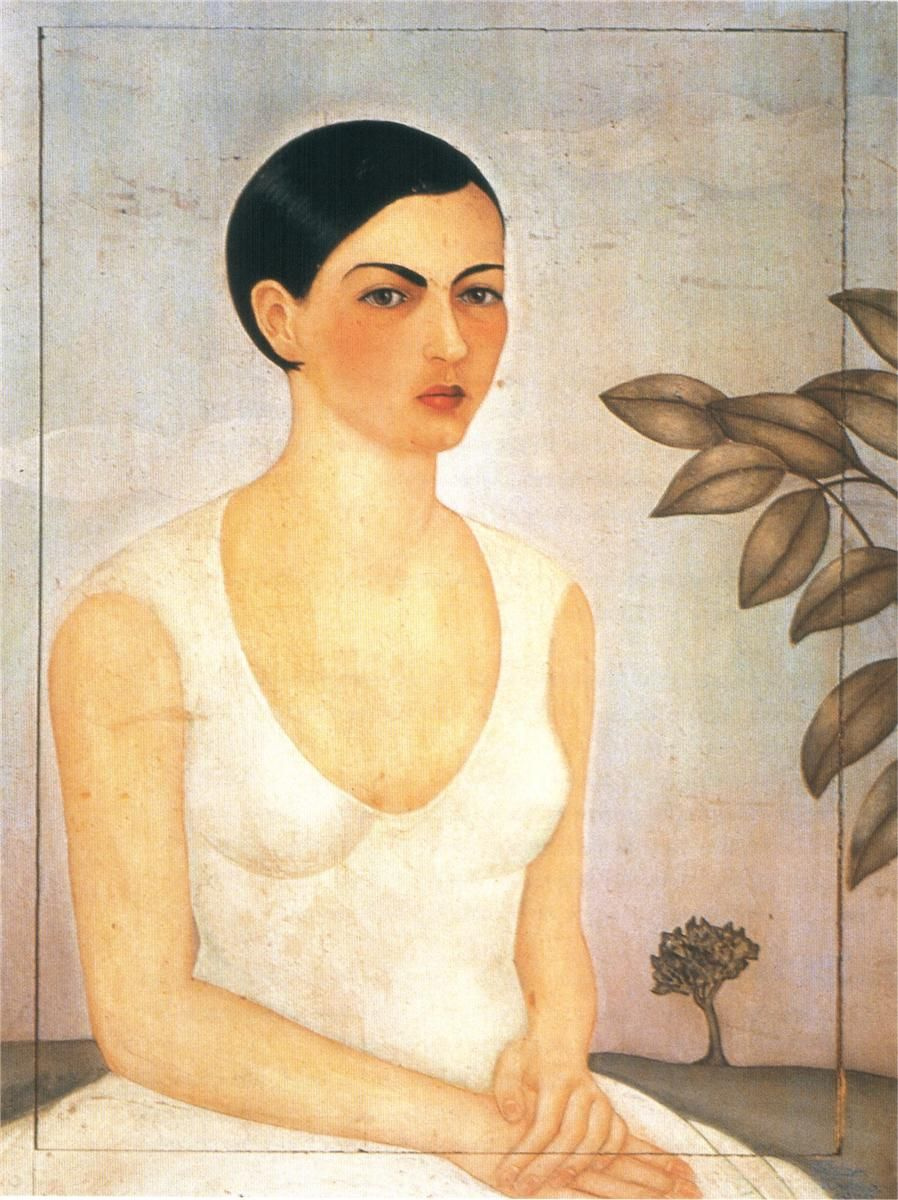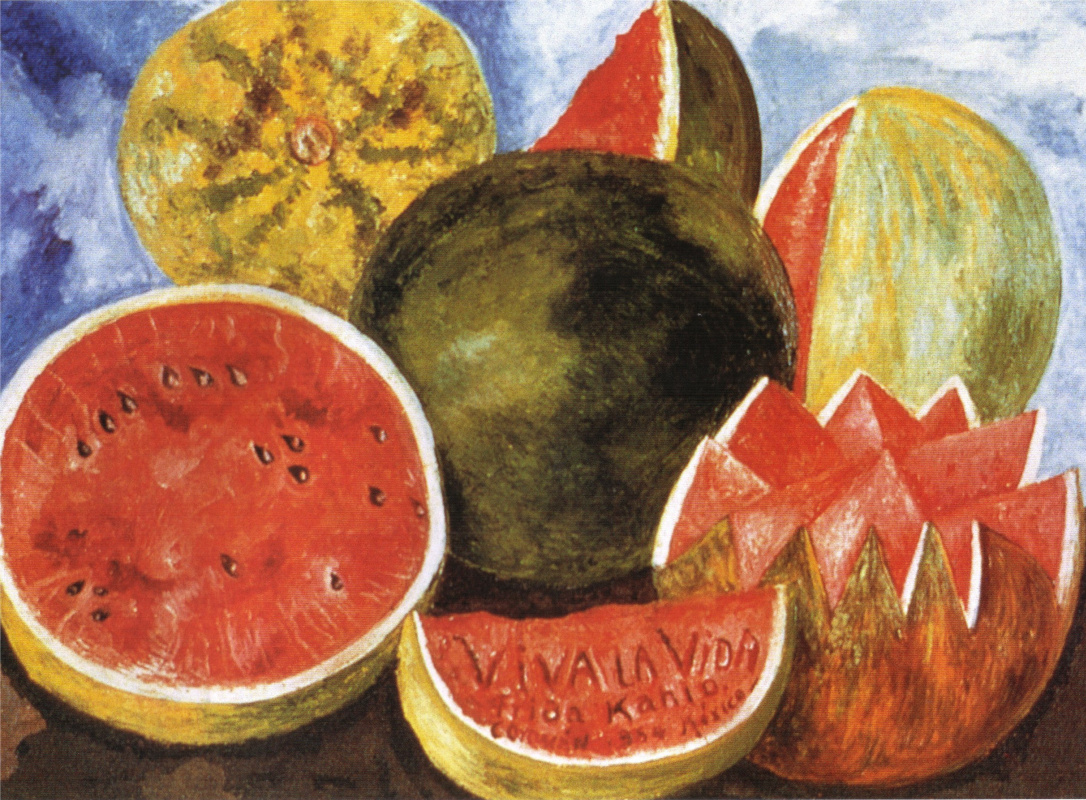Romantic people would say that Diego and Frida were destined to live life together. However, this love story was very far from ideal. It was very manifold and comprised both unrestrained passion and all-consuming anger, tenderness and betrayal, devotion and jealousy, love and pain.

The Fearless Girl
First, Diego heard her voice. In 1922, the artist was painting a mural at an auditorium of the National Preparatory School of Mexico City. For several times, an invisible girl, who was hiding behind the colonial pillars, shouting pranks at him. Afterwards, one night, as Rivera was painting up on the scaffolding and his then-wife Lupe Marín was working below, they heard loud commotion coming from a group of students pushing against the auditorium door; after a moment the door flew open, and a girl was propelled inside."She was dressed like any other high school student but her manner immediately set her apart. She had unusual dignity and self-assurance, and there was a strange fire in her eyes. She looked straight up at me. ‘Would it cause you any annoyance if I watched you at work?' she asked. ‘No, young lady, I’d be charmed,' I said.

Diego Rivera at work.
She sat down and watched me silently, her eyes riveted on every move of my paint brush. After a few hours, Lupe’s jealousy was aroused, and she began to insult the girl. But the girl paid no attention to her. This, of course, enraged Lupe the more. Hands on hips, Lupe walked toward the girl and confronted her belligerently. The girl merely stiffened and returned Lupe’s stare without a word. Visibly amazed, Lupe glared at her a long time, then smiled, and in a tone of grudging admiration, said to me, "Look at that girl! Small as she is, she does not fear a tall, strong woman like me. I really like her."
When she left, she said only, "Good night." A year later I learned that she was the hidden owner of the voice which had come from behind the pillar and that her name was Frida Kahlo. But I had no idea that she would one day be my wife."
When she left, she said only, "Good night." A year later I learned that she was the hidden owner of the voice which had come from behind the pillar and that her name was Frida Kahlo. But I had no idea that she would one day be my wife."
Self-portrait
1922
«The Wings of a Blackbird»
It wasn’t until several years later that the two crossed paths again. During this time Frida has been involved in a terrible car crash, which almost cost her life, spent several months with plaster, learnt how to walk again and started painting.That day, Rivera was at work on one of the frescoes at the Ministry of Education, when he heard a girl shouting, "Diego, please come down from there! I have something important to discuss with you!" The artist remembered, "On the ground beneath me stood a girl of about eighteen. She had a fine nervous body, topped by a delicate face. Her hair was long; dark and thick eyebrows met above her nose. They seemed like the wings of a blackbird."
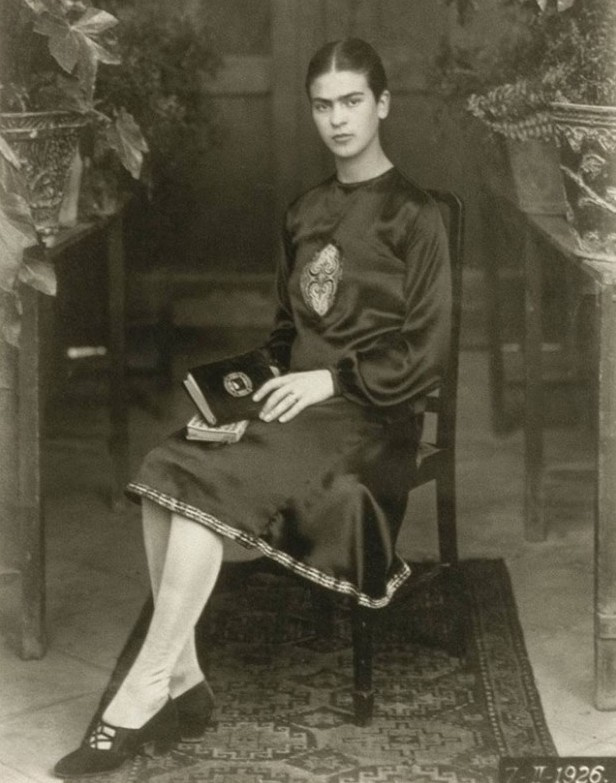
Frida Kahlo at the age of 18.
As intrigued Rivera climbed down the scaffolding, Frida made no attempt to conceal her spirited attitude, "I didn’t come here for fun. I have to work to earn my livelihood. I have done some paintings which I want you to look over professionally. I want an absolutely straightforward opinion, because I cannot afford to go on just to appease my vanity."
As Diego looked at three portraits of women Frida brought, he was impressed. "The canvases revealed an unusual energy of expression, and true severity. They showed none of the tricks in the name of originality that usually mark the work of ambitious beginners. It was obvious to me that this girl was an authentic artist."
As Diego looked at three portraits of women Frida brought, he was impressed. "The canvases revealed an unusual energy of expression, and true severity. They showed none of the tricks in the name of originality that usually mark the work of ambitious beginners. It was obvious to me that this girl was an authentic artist."
Self portrait in a velvet dress
1926, 79×58 cm
Frida, however, having been warned of Rivera’s reputation as a ladies' man, was skeptical of Diego’s words. She had not come to him looking for compliments, she wanted the criticism. Rivera replied her, "In my opinion, no matter how difficult it is for you, you must continue to paint."
Finally, the girl asked Rivera to come to her place to have a look at the rest of her paintings. It is only after providing her address that she told Rivera her name — a revelation that stopped him dead in his tracks as he remembered the fearless assertive girl who played pranks on him. He surely agreed to come.
Finally, the girl asked Rivera to come to her place to have a look at the rest of her paintings. It is only after providing her address that she told Rivera her name — a revelation that stopped him dead in his tracks as he remembered the fearless assertive girl who played pranks on him. He surely agreed to come.
Diego wrote: "I did not know it then, but Frida had already become the most important fact in my life. And she would continue to be, up to the moment she died, twenty-seven years later."
An Elephant and a Dove
Frida’s parents were against this marriage. It hurt them to see their frail daughter next to this monster, a huge, ugly, fat womanizer. Guillermo and Matilda called this union "the marriage between an elephant and a dove". But the girl’s father understood that Rivera had the financial means so Frida would not have to work.On one of Diego’s visits to the Kahlo home, Guillermo took Diego aside and said,"My daughter is sick and always will be… she's intelligent but not pretty… I see that you are interested in my daughter… eh.?" When Rivera replied that he was, Kahlo added, "She's a devil". Rivera replied, "I know". "Well, I’ve warned you," Guillermo said.
Frida and Diego got married on August 21, 1929. At the wedding reception that followed, Diego proceeded to get obnoxiously drunk. In a drunken rage he broke another man’s finger, broke several items on the table and brandished his pistol. Frida was furious at his behaviour, she did not move in with Diego until several days later.
Arsenal
1928
Frida soon became pregnant but had to undergo an abortion due to medical reasons. Frida disparately wanted a child by Diego but Diego did not want children.
Shortly after their marriage, Diego was expelled from the Communist Party after accepting a large commission from the Mexican government. Frida, demonstrating her loyalty to him, also left the Communist Party, although they did not abandon the goals of Communism. Frida generally preferred to be a wife "at her husband", at least for the first time. Frida had painted only to amuse herself and never considered herself to be an artist. When Diego received several large orders in the USA, Frida accompanied him, but remained in his shadow. Americans almost idolized Rivera but scrutinized Frida as just an object of curiosity.
Shortly after their marriage, Diego was expelled from the Communist Party after accepting a large commission from the Mexican government. Frida, demonstrating her loyalty to him, also left the Communist Party, although they did not abandon the goals of Communism. Frida generally preferred to be a wife "at her husband", at least for the first time. Frida had painted only to amuse herself and never considered herself to be an artist. When Diego received several large orders in the USA, Frida accompanied him, but remained in his shadow. Americans almost idolized Rivera but scrutinized Frida as just an object of curiosity.

The American Dream
Six months in San Francisco were very productive for Kahlo, because she almost did not communicate with anyone. In San Francisco, the paintress created one of her most famous paintings, "Frida and Diego Rivera". She was surprised to see her painting at the exhibition of women artists. It was the first public showing of her work.Rivera was untrue to his wife almost from the first day of their coupledom. In San Francisco, he began an affair with the tennis beauty Helen Moody, who was the model for one of the panels in a mural he made. In retaliation, Frida began a sexual affair with Christina Hastings, the wife of one of Diego’s assistances. During this time, the pain worsened in Frida’s right leg, disfigured by poliomyelitis, and she was hospitalized. The well-known surgeon Dr. Leo Eloesser diagnosed her physical problems as being stress related and recommended bed rest and a healthy diet.
The spouses returned to Mexico separately: Frida in May 1931, and Diego in June. During the separation Kahlo had time to get acquainted with the New York photographer Nickolas Murray. Their secret "on-again/off-again" love affair lasted for nearly 10 years.
Soon, Diego and Frida sailed to New York to attend the opening of Diego’s retrospective exhibition at the Museum of Modern Art. Diego basked in glory. Enthusiastic articles, dedicated to him, referred Kahlo only as "Mrs. Rivera". Following the next order, the couple moved to Detroit, which Frida described as "a shabby old village". Frida became pregnant once again but after only three and a half months her second pregnancy ended in miscarriage at the Henry Ford Hospital. She spent the next 13 days recovering in the hospital and painted one of the most tragic paintings, dedicated to the deceased son.
Soon, Diego and Frida sailed to New York to attend the opening of Diego’s retrospective exhibition at the Museum of Modern Art. Diego basked in glory. Enthusiastic articles, dedicated to him, referred Kahlo only as "Mrs. Rivera". Following the next order, the couple moved to Detroit, which Frida described as "a shabby old village". Frida became pregnant once again but after only three and a half months her second pregnancy ended in miscarriage at the Henry Ford Hospital. She spent the next 13 days recovering in the hospital and painted one of the most tragic paintings, dedicated to the deceased son.
Henry Ford Hospital
1932, 30.5×38 cm
In early September of 1932, Frida received word that her mother was gravely ill. Matilda passed away a week after her daughter’s arrival. Back in Detroit, she had too much time, while Diego worked long hours in an effort to complete the Detroit murals on schedule, and had little time for Frida. In a nostalgia for Mexico, Frida starts drawing again and, when Diego again takes her back to New York, she paints the famous painting "My Dress Hangs There", criticizing the dull industrialized US world.
Diego’s work on a mural in the Rockefeller Center ended in a scandal: among other heroes, the artist painted Lenin, which caused the indignation of the customer. They did not find a compromise, the commission had been terminated, and the unfinished mural was destroyed. Because of the scandal, Rivera lost other commissions. Diego realized they were broke, so he agreed to return to Mexico.
Diego’s work on a mural in the Rockefeller Center ended in a scandal: among other heroes, the artist painted Lenin, which caused the indignation of the customer. They did not find a compromise, the commission had been terminated, and the unfinished mural was destroyed. Because of the scandal, Rivera lost other commissions. Diego realized they were broke, so he agreed to return to Mexico.
There hangs my dress
1933, 46×55 cm
Pain and Happiness
In early 1934, Frida experienced several blows at once. Her third pregnancy also ended with miscarriage. Shortly afterwards Frida learned that Diego was having an affair with her younger sister Christina. Frida suspected Diego was having yet another affair but never ever considered the fact that "the other woman" might be her own sister. She felt betrayed by the two people she loved most of all. Frida left Diego and took her own apartment for several months. As she used to, she poured out her pain onto her canvas. She painted a scene of brutal murder, described in the newspapers, and called the painting "A Few Small Nips!"
A few small nips!
1935, 30×40 cm
However, despite the betrayal, Frida could not remain apart from Diego for a long time. The spouses reconciled in the late 1935, but they lead separate lives. Frida kept herself on one side of the duplex structure and Diego on the other. The two separate quarters were connected on the top level by a foot bridge. During her separation from Diego, Frida engaged in several affairs with both men and women. Diego, who had never been too faithful, was infuriated by her affairs, so Frida was careful to keep those escapades a secret.
Portrait of Christina my sister
1928, 99×81.5 cm
One of her diary entries: "Diego = my husband / Diego = my friend / Diego = my mother / Diego = my father / Diego = my son / Diego = me / Diego = Universe".
In January of 1937, Leon Trotsky and his wife, Natalia Sedova, arrived in Mexico, where Leon had been granted political asylum. They took up residence with Frida’s father Guillermo in the "Blue House", where Frida had spent her childhood. Shortly after their arrival, Frida and Trotsky became close and engaged in a secret and passionate relationship. Trotsky’s political status and Diego’s admiration for him made him a prime target for an affair that would give Diego a few more "nips" for his affair with Cristina. Frida and Trotsky would converse only in English, a language which was still foreign to his wife Natalia. They would pass love notes to each other hidden in books that they would loan each other. However, Sedova didn’t have to understand English to notice their affair.
But Frida soon grew tired of "the old man", and the affair ended. After their relationship, Frida painted a self-portrait and gave it to Trotsky who hung it on the wall in his study . When the Trotsky’s moved from the Blue House, at the request of his wife, he left the painting behind.
But Frida soon grew tired of "the old man", and the affair ended. After their relationship, Frida painted a self-portrait and gave it to Trotsky who hung it on the wall in his study . When the Trotsky’s moved from the Blue House, at the request of his wife, he left the painting behind.
Self portrait dedicated to Leon Trotsky
1937, 87×70 cm
During 1937 Frida again began to paint and it was during this period that she produced some of her best work. Almost hopeless, she sent them to an exhibition in Mexico City. During the exhibit, Frida’s work caught the eye of the New York gallery owner Julien Levy. In October 1938, Frida traveled to New York for her first one-person exhibition at the Julien Levy Gallery. The success was grandiose: this time Frida had achieved the status of artist and was no longer referred to as just "the wife of Diego Rivera". Then she had an exhibition in Paris, where one of Kahlo’s self-portraits was acquired by the Louvre. The photo of the artist in her exotic Mexican outfit with flowers in her hair was placed on the cover of the French Vogue.
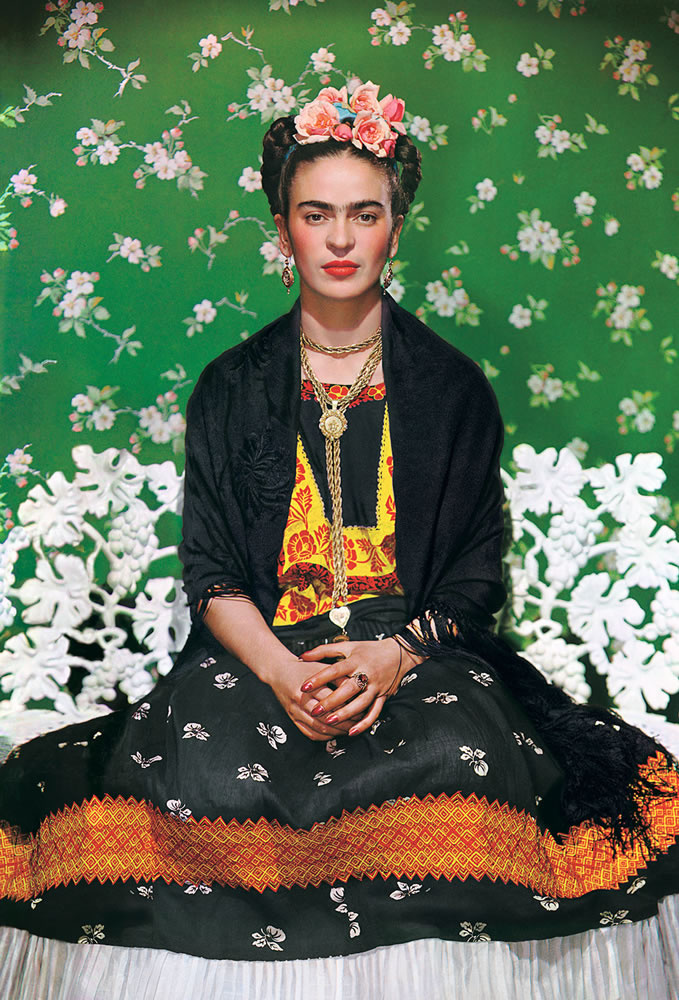
Frida Kahlo’s photo at the Vogue cover page.
Despite her success, Frida felt infinitely lonely and desperately wanted to return home. At the same time, her long-standing romance with Nickolas Murray ended, he decided to marry another woman. Frida now felt deserted and betrayed by all of the men in her life. She finally returns to Mexico and remains in the "Blue House". Frida and Diego’s relationship continued to deteriorate, and they divorced the same year. After the divorce, the artist painted the famous double portrait "The Two Fridas": one of the heroines is the one Diego loved, and the second one is the one he rejected. However, next year the couple would marry again.
Two Fridas
1939, 173.5×173 cm
To the Last Breath
After the death of her father Guillermo Kahlo in 1941, Frida’s physical decline became more acute over the next few years. She underwent several radical operations on her back and leg, confinement in a series of corsets, and could no longer live without huge doses of painkillers. She became very depressed and began keeping a diary to document her emotional feelings in text and drawings until her death.In 1948, Diego began an affair that caused a public scandal. Actress Maria Felix had a weakness for ugly men, and she wished to marry Rivera at all costs. Diego asked Frida for a divorce. Thinking that it was all just a big joke she agreed… but when she realised the truth, it drove her into a fit of rage and revenge. She called the newspapers to tell them of the "illicit" relationship between Diego and Maria; the next day the story broke on the front page. The Catholic Mexicans wholeheartedly sided with the deceived wife, and Maria quickly ended the affair.
An entry from Frida’s diary: "Diego is not anybody’s husband and never will be, but he is a great comrade".
Frida spent most of the year 1950 in the hospital. She underwent a total of 7 operations. Most nights Diego slept in a room next to hers. The next years, she was confined to her bed, but she did not stop painting. Most of her late works are still life paintings glorifying life.
Viva la vida! Watermelons
1954, 50.8×59.5 cm
Despite the constant pain and apprehension of the approaching death, Frida was happy. She managed to live up to her first personal exhibition in her native Mexico. On the opening day, Frida’s doctor told her she was not well enough to attend the opening and she was not to leave her bed, so her bed was loaded into the back of a truck, driven to the exhibition opening and set up in the center of the gallery. Thus she became a part of her own exhibit.
The anguishes of the artist did not end, the health problems grew like a snowball. In 1953, the gangrene on Frida’s foot worsened and doctors were forced to amputate her leg. A year later, she spent two months in the hospital with pneumonia. The disease did not want to retreat and finally deprived Frida’s health.
The anguishes of the artist did not end, the health problems grew like a snowball. In 1953, the gangrene on Frida’s foot worsened and doctors were forced to amputate her leg. A year later, she spent two months in the hospital with pneumonia. The disease did not want to retreat and finally deprived Frida’s health.
Diego spent the night before her death at her bedside. Kahlo gave her husband the ring she bought him on the anniversary of their wedding. Diego was surprised: there were still 17 days left until the date. Frida answered: "I feel that I will leave you very soon." When she died the next morning, Rivera refused to believe it for a long time, and the doctors hardly managed to convince him. The whole next day people were coming to the "Blue House" to say goodbye to Frida. More than 500 people came to the funeral.

Diego Rivera died three years later from cardiac arrest. He asked that after his death he be cremated and the ashes put in the "Blue House" next to the ashes of Frida. However, his two daughters and his last wife refused to fulfill the artist’s request.
Arthive on Instagram
Cover illustration: detail of the painting "Frida and Diego Rivera" by Frida Kahlo.
Cover illustration: detail of the painting "Frida and Diego Rivera" by Frida Kahlo.







